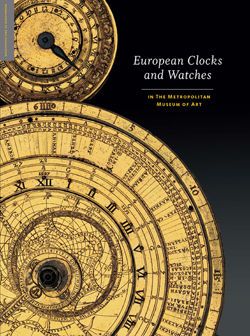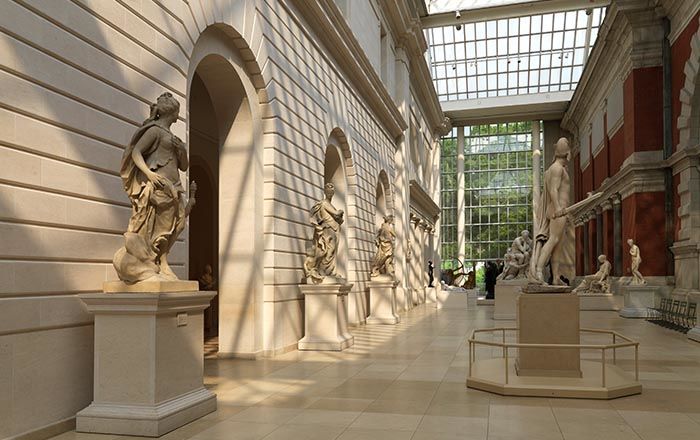Longcase clock
Clockmaker: Thomas Dickenson British
Case maker: possibly James Fielding British
Not on view
Both form and ornament combine to make this clock an unusually elegant example of an English country clock, as well as an exceptionally good timekeeper. The tall, narrow case has a high rectangular plinth with a Hepplewhite-style apron and two carved front feet but no back feet. The trunk is flanked by applied quarter-round columns that are mounted with brass bases and capitals. Its door is arched at the top and ornamented with inlays of light-colored wooden strips forming a large oval, and the keyhole escutcheon is a lozenge-shaped inlay of bone. The hood has a pagoda top with three brass finials, the center finial on a wooden plinth with ornamental fretwork attached to the sides. In the center of the top appears a patera-like aperture with openwork ornament. The elliptical wooden-framed glass door for the dial is flanked by freestanding mahogany colonettes with brass bases and capitals. Like the quarter-round columns, the colonettes are inlaid with strips of light-colored wood in imitation of fluting, and all of the architectural elements of the case are accented by comparable inlays. A printed paper label for the equation of time, titled “MOORE 1826,” with a notice of its intended use for the regulation of clocks and watches in 1823, is attached to the inside of the door to the trunk,[1] and the back board of the trunk has four holes intended for securing the clock to a wall.
The dial of the clock is laid out within a larger ellipse, not with a chapter ring of hours, but with a ring of minutes (labeled 5–60, by fives). A subsidiary ring painted with Arabic numerals 1–12 below the arbor for the minute hand records the hours, and a third ring above the arbor is painted with Arabic numerals 15–60, for fifteen-second intervals, but also marked for each second. All of the hands are made of sheet brass, the minute hand being the most prominent, and the hole for the single winding square is bordered with brass.
The movement consists of two trapezoidal plates formed from unusually thick brass and held apart by six pillars. The movement has a single train of three wheels and a Graham-type dead-beat escapement. The braided brass wire (a replacement) for suspending the single weight has a small hook at one end, and a wire loop is attached to the seat board, to which the end of the wire can be attached.[2] The original pendulum is lost, but the position of a long scar on the interior of the back of the trunk suggests that the clock might originally have been fitted with a simple, but rare, pendulum with a wooden shaft for temperature compensation. The clock beats seconds and runs for eight days on a single winding.
Although there are no clocks among the compilation of furniture designs made by George Hepplewhite’s widow and published in three editions beginning in 1788, the design of the Dickinson clockcase owes a great deal to some engravings included in Hepplewhite’s The Cabinet-Maker and Upholsterer’s Guide. Aside from the apron and feet of this clock, a preference for the ellipse clearly apparent in the design of the case surely derives from such case pieces as the wardrobe illustrated in plate 88 of the third edition (1794) of the Guide, although the ellipses may ultimately have descended from designs for elliptical furniture ornament and for pier glasses by the great English Neoclassicist Robert Adam (1728–1792).[3] More elaborately ornamented ellipses, such as those in the designs of tops for Pembroke tables, are to be found in plate 63 of the third edition of Hepplewhite’s Guide, as well as prototypes for the vegetal ornament in the aperture of the hood of the Dickinson clock. Furthermore, the fashion for elliptical pier glasses in Adam’s designs and in Hepplewhite’s publications must have influenced the shape of the dial of the Dickinson clock, at least indirectly.
Painted elliptical dials, in themselves, do occur in late eighteenth-century English country clocks. Many of them are known to have been made in Birmingham or Liverpool and to have been adapted for use in clocks made in various parts of the country. But these dials ordinarily consisted of two distinct portions, the bottom containing a true circular chapter of hours and the top ornamented with painted landscapes, arrangements of fruit and flowers, or lunar displays.[4] In contrast, the dial of the Dickinson clock has no ornament and allows especially easy reading of minutes and seconds. In fact, its deceptively simple layout owes more to the standard designs for regulators, the very accurate clocks made for the use of natural philosophers and astronomers. Such layouts are not usually found on ordinary longcase clocks, either London-made or provincial. They are quite rare and probably ought to be understood as having been specially made for precision clocks. Coupled with the fact that the Dickinson clock has a finely made movement with a loud-ticking dead-beat escapement and probably once had a temperature-compensated pendulum, it seems possible that it was intended for use by an amateur astronomer, especially since small, private observatories were very much in vogue in the later eighteenth and early nineteenth centuries following the construction in 1760 of King George III’s private observatory at Kew.[5]
There is some evidence that the maker of the movement, Thomas Dickinson (active 1790–1827), was a member of the Clockmakers’ Company in London about 1799.[6] The authors of a monograph on Lincolnshire clockmaking, A. S. H. Wilbourn and R. Ellis, have found no evidence, however, for his presence in Boston (Lincolnshire) before April 26, 1804, when he advertised in the Lincoln, Rutland & Stamford Mercury as the local purveyor of mathematical instruments manufactured by the London establishment of Joseph and James Cox.[7] His advertisements in the regional newspaper continued until May 25, 1827.
Dickinson was an active clockmaker, rather than simply a retailer, as indicated by a record of July 28, 1807, that bound James Fielding (active 1804–after 1820) as an apprentice clock- and watchmaker to him for the customary seven years.[8] The somewhat puzzling signature of “Jas Fielding Clock Maker” on the interior of the trunk of the Museum’s clock is difficult to explain in light of the record of his apprenticeship to Dickinson in the same year. By November 10, 1809, however, Dickinson was advertising for a journeyman clock- and watchmaker, and again on May 24, 1810, for another.[9] He married in 1809, and records indicate that from 1804 until at least as late as 1820 his place of work was at the Market Place in Boston, but local directories were still listing him there until as late as 1829.[10]
Wilbourn and Ellis remark that by the early nineteenth century complete movements were not commonly made in Lincolnshire and that it is not known who actually made the movements in most Lincolnshire clocks of the period.[11] To judge from the evidence that Dickinson took an apprentice clockmaker and that he had at least one journeyman assistant, if not more, it is probable that he was, in fact, making the movements for his longcase clocks.
Cecile L. Mayer owned this clock until it was bequeathed to the Museum in 1962.
Notes (For key to shortened references see bibliography in Vincent and Leopold, European Clocks and Watches in the Metropolitan Museum of Art. NY: The Metropolitan Museum of Art, 2015)
[1] John Hamilton Moore (1734–1807), author of The Practical Navigator and Seaman’s New Daily Assistant (London, 1772), gave practical instruction and sold maps, charts, and mathematical instruments on Little Tower Hill in London. After his death, Moore’s sons and his son-in-law Robert Blachford (flourished 1804–40) carried on the business at the same address. See Taylor 1966, pp. 240–41, no. 512, and p. 357, no. 1086. Further history of the firm appears in Howse and Sanderson 1973, p. 127.
[2] Wilbourn and Ellis 2001. The authors note (p. 160) that this arrangement is typical of South Lincolnshire and, thus, Boston clockmaking.
[3] See, for example, an engraving of furniture for Kenwood House, dated 1774, illustrated in Ward-Jackson 1958, p. 59, no. 229. Adam’s influence was undoubtedly responsible for the elliptical forms to be found in the engraved designs in Hepplewhite’s Guide.
[4] Loomes 1975, p. 25.
[5] See Taylor 1966, p. 103, who noted the contributions to the catalogue of stars made by private individuals, stating that one James South (1785–1867) alone added 458 stars to the catalogue he had compiled with John F. W. Herschel (1792–1871), son of William Herschel (1738–1822), King George III’s astronomer. For the king’s interest in astronomy and timekeeping and his patronage of clockmakers, see Jagger 1983, pp. 90–119. See also Morton and Wess 1993, pp. 17–37.
[6] See Britten 1982, p. 425.
[7] Wilbourn and Ellis 2001, p. 36. Joseph Cox (active 1789–1822) was a maker of optical and mathematical instruments in London. He was apparently succeeded by James Cox (active 1822–55) at 5 Barbican in London. See Clifton 1995, pp. 68–69.
[8] Moore 2003, p. 99.
[9] Wilbourn and Ellis 2001, pp. 36–37.
[10] Ibid., p. 37.
[11] Ibid., p. 157
This image cannot be enlarged, viewed at full screen, or downloaded.


